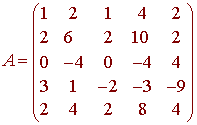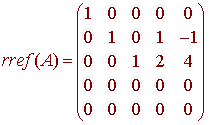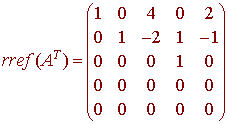Math 203 Practice Midterm 2
Please
work out each of the given problems. Credit
will be based on the steps towards the final answer.
Show your work.
Let L: R2 --> R3 be a linear transformation such that
L
(1,4) = (1,-1,3)
and L
(0,2) = (2,1,4)
Find L(1,0)
Solution
c1(1,4) + c2(0,2) = (1,0)
This gives
c1
= 1
4c1 + 2c2
= 0
we rref the matrix

hence
(1,0) = 1(1,4) - 2(0,2)
Now take the linear transformation
L(1,0) = L( (1,4) - 2(0,2) ) = L((1,4)) - 2 L((0,2))
(1,-1,3) - 2(2,1,4) = (-3, -3, -5)
Of the following two
subsets of the vector space of differentiable functions, determine which is a
subspace. For the one that is not a
subspace, demonstrate why it is not. For
the one that is a subspace, prove that it is a subspace.
A.
S = {f | f(3) = f '(3)}
B.
T = {f | f(0)f '(0) = 0}
Solution
A. This is a subspace. We need to show that the two closure properties hold.
f(3) = f '(3) and g(3) = g'(3)
then
(f + g)(3) = f(3) + g(3) = f '(3) + g'(3) = (f + g)'(3)
hence f + g is in the subset. If c is a constant, then
(cf)(3) = cf(3) = cf '(3) = (cf)'(3)
hence cf is in the subset. Since both closure properties are true, we can conclude that S is a subspace.
B. This set is not a subspace. Let f(t) = 1 and g(t) = t. Then
f(0)f '(0) = (1)(0) = 0 and g(0)g'(0) = (0)(1) = 0
so both f and g are in T. However
(f + g)(0)(f + g)'(0) = [f(0) + g(0)] [f '(0) + g'(0)] = (1 + 0)(0 + 1) = 1
Hence T is not closed under addition.
Let S
= {t2, t2 + 2t, t2 + 3}
and T
= {2t - 1, 5t - 3, t2}
be subsets of P2
A. Prove that S is a basis for P2.
Solution
Since the dimension of P2 is 3 and S has 3 vectors, we need only prove that the vectors in S are linearly independent. If we let
c1t2 + c2(t2 + 2t) + c3(t2 + 3) = 0
then we can combine like terms to obtain
(c1 + c2 + c3)t2 + 2c2t + 3c3 = 0
If a polynomial equals zero then each of the coefficients equal zero. We get
c1
+ c2 + c3 = 0
2c2
= 0
3c3 = 0
The matrix for this equation is

has determinant equal to 6. Since the determinant is nonzero, the system has only the trivial solution, hence the three vectors are linearly independent. We can conclude that S is a basis for P2.
B. Find the transition
matrix PS<--T
.
Solution
Let E be a standard basis E = {t2, t, 1} and look at the following diagram


Suppose that you want to change the graphic
file from the one on the left to the one on the right.
What is the matrix needed to adjust the pixels appropriately?
Assume the center of the picture is the origin.


Solution

Hence

Let

A. Find the rank and the nullity of A.
Solution
We find

Since there are three corners, the rank of A is 3. From the equation
rank(A) + nullity(A) = n
we get
nullity(A) = 5 - 2 = 2
B.
Find a basis for the Null Space of A.
{(0,-1,-2,1,0), (0,1,-4,0,1)}
C.
Find a basis for the Column Space of A
using columns of A.
{(1,2,0,3,2), (2,6,-4,1,4), (1,2,0,-2,2,2)}
D. Find a basis for the Row Space of A using rows of A.
We find the basis for the column space of AT. We have

Hence we take the first, second, and fourth rows of A.
{(1,2,1,4,2), (2,6,2,10,2), (3,1,-2,-1,-9)}
Let S = {v1, v2, ..., vn} be a set of linearly independent vectors and let v be a vector in the span of S. Prove that v can uniquely be written as a linear combination of elements of S. That is that prove that if
v = a1v1
+a2v2 + ... + anvn
and
v
= b1v1
+b2v2 + ... + bnvn
then
a1 = b2, a2 = b2, ... , an = bn
Suppose that
v = a1v1
+a2v2 + ... + anvn
and
v
= b1v1
+b2v2 + ... + bnvn
Then
a1v1 +a2v2 + ... + a2vn = b1v1 +b2v2 + ... + bnvn
Moving everything to the left hand side and combining like terms, we get
(a1 - b1)v1
+ (a2 - b2)v2 + ... + (an- bn)vn
= 0
Since the vectors are linearly independent, all of the coefficients are zero, that is
(a1 - b1) = (a2 - b2) = ... = (an- bn) = 0
so that
a1 = b1 , a2 = b2 , ... , an = bn